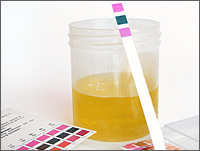Your doctor may order a urinalysis, a test of urine, to detect a number of problems, including kidney disease, urinary tract infections and diabetes. The test involves checking the concentration, appearance, and content of urine. If you do not receive a normal result, it usually means that you have an underlying illness or disease. So what is considered normal for a urine test?

Normal Urinalysis Results and Interpretation of Abnormal Results
1. Appearance
Normal: Urine is clear or light yellow in color with no odor.
Clinical Implications: The appearance of your urine may change when it contains bacteria, white blood cells, fat, red blood cells, or chyle. A changed appearance may indicate urinary tract or renal infection.
The appearance of your urine may also change because of certain drugs. Pyridium can change the urine to dark orange color and dorban can make it look red.
Diabetes, dehydration and starvation can make the urine have a fruity odor.
2. PH
Normal Values: 4.5 to 7.2
Clinical Implications: Normally, your urine is slightly acidic, but an infection can make it alkaline. There may be a change in the pH level of your urine at different times during the day. Your diet and water intake can also make a difference. An optimum pH is usually about 6.0.
3. Specific Gravity
Normal Values: 1.005 to 1.025
Clinical Implications: It refers to the weight of your urine as compared to water. Specific gravity goes up when your urine is highly concentrated, and specific gravity comes down when the water content is high.
Low specific gravity may indicate conditions such as nephrogenic diabetes insipidus, diabetes insipidus, pyelonephritis, or acute tubular necrosis. High specific gravity indicates dehydration, nephritic syndrome, liver failure, acute glomerulonephritis, heart failure, or shock. If you don't have a normal urinalysis result, ask your doctor for help.
4. Protein
Normal Values: Less than 150 mg/d
Clinical Implications: It is normal to have a small amount of protein in your urine, but the presence of albumin usually indicates fever, renal disease, tumors, hypertension, etc. Pregnancy and extreme muscle exertion may also make some protein to appear in your urine.
5. Glucose and Ketones
Normal Values: Ketones: None; Glucose: Less than 130 mg/d
Clinical Implications: There may be trace amounts of glucose in the urine after eating a large meal. You are likely to spill glucose into the urine if you have diabetes. Ketones are the outcome of incomplete fat metabolism and may appear in your urine in diabetes, after diarrhea, or in starvation states.
6. Red Blood Cells (RBCs)
Normal Values: 0 to 3 RBCs
Clinical Implications: Blood in urine indicates urinary tract infections, but the microscopic exam is required to confirm bleeding and inflammation in the urinary tract. A level of higher than 3 RBCs indicates a disease condition, and may happen when you have cystitis. Trauma and many other conditions can also cause bleeding.
7. White Blood Cells (WBC's)
Normal Values: Less than 2-5 WBCs/hpf
Clinical Implications: Normal urinalysis result shows little WBCs. The presence of WBCs in the urine usually indicates inflammation/infection of the renal system. An infection in the kidney or the urinary tract may cause the inflammation. Obstructive disorders can also cause WBCs to show in your urine, but there will be other symptoms as well.
8. Casts
Normal Values: 0 to 5 hyaline casts/lpf
Clinical Implications: These are solid, formed elements that may appear in the urine. These elements are formed after cell destruction and from other waste materials. These casts can be of different types and may also be formed from WBCs which indicate infections. The presence of casts alone does not help make a correct diagnosis though.
9. Crystals and Other Components
Normal Values: Crystals: Occasionally; Bacteria: None; Yeast: None
Clinical Implications: It is possible for some crystals to show in your urine without a disease condition, but the presence of calcium oxalate crystals usually indicates ethylene glycol ingestion or hypercalcemia. A problem with metabolism may show cystine crystals in the urine and make your urinalysis result abnormal.
The presence of yeast cells, bacteria, and parasites in urine sediment usually indicates contamination of external genitalia or genitourinary tract infection. Yeast cells usually look like RBCs, but they have ovoid shape. Trichomonas vaginalis is the most common parasite found in urine and it indicates problems such as urethritis, vaginitis, and prostatovesiculitis.
How to Prepare for Urinalysis
It is a good idea to drink plenty of water before you go for your test. This may really help get correct and normal urinalysis result. You will also be able to provide your lab assistant with an adequate urine sample. There is no need to change your diet or fast before the urinalysis test.
Just make sure to inform your doctor about any supplements or medications you may be taking. Certain medications and supplements can change your urinalysis result. The most common names are metronidazole, vitamin C supplements, nitrofurantoin, methocarbamol, anthraquinone laxatives, and riboflavin. Keep in mind that illegal drugs can also change your result, so be sure to inform your doctor of any substances you may be using.
